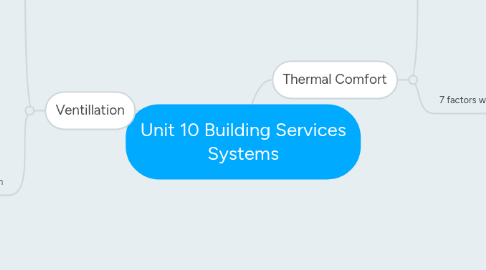
1. Thermal Comfort
1.1. BS EN ISO 7730:2015
1.1.1. The condition of mind which expresses satisfaction with the thermal environment
1.2. 7 factors which contribute to thermal comfort
1.2.1. Environmental factors
1.2.1.1. Air Tempreture
1.2.1.1.1. Heat Transfer
1.2.1.1.2. This is the temperature of the air surrounding the body
1.2.1.2. Mean Radiant Air Tempreture
1.2.1.2.1. Average temperature of all walls in an area surrounding a specific point
1.2.1.3. Air Velocity
1.2.1.3.1. The speed of the air in any given direction
1.2.1.4. Humidity
1.2.1.4.1. the amount of water vapour present in air expressed as a percentage of the amount needed for saturation at the same temperature
1.2.2. Personal Factors
1.2.2.1. Metabolism
1.2.2.1.1. Rate at which our body burns calories
1.2.2.2. Clothing
1.2.2.2.1. Humans wear clothes as we have an inability to retain heat
1.2.2.3. Skin Temperature
1.2.2.3.1. Vaires around 31 Deg C
2. Ventillation
2.1. Why do we need ventilation
2.1.1. Helps control internal temperatures and humidity levels
2.1.2. Fulfils fresh air requirements
2.1.2.1. Recommended Fresh air for Humans
2.1.2.1.1. 14.3 Litre per second
2.1.2.1.2. Limits percentage of CO2 in the air
2.1.3. Removes exhaust gases
2.2. Types of Ventillation
2.2.1. Natural Ventillation
2.2.1.1. Ventilation without the use of machinery
2.2.1.1.1. For natural ventilation you need a difference of pressure
2.2.1.2. Windows
2.2.1.2.1. Advantages
2.2.1.2.2. Disadvantages
2.2.1.2.3. Cross ventilation system
2.2.1.3. Passive stack ventilation
2.2.1.3.1. Vertical Ventilation
2.2.1.3.2. Hot air rises upwards
2.2.1.4. Single Sided Ventilation
2.2.1.4.1. Wind entering and existing through one side of the building
2.2.1.5. Cross Ventilation
2.2.1.5.1. Fresh air enters through one side of the building and exits the opposite side
2.2.2. Mixed Mode Systems
2.2.2.1. Combination of natural and mechanical ventilation
2.2.2.1.1. No heating or cooling in mixed node systems
2.2.2.1.2. Mechancial side is only used to bring air into/out of a building
2.2.2.1.3. Advantages
2.2.2.1.4. Disadvantages
2.2.3. Mechanical Ventilation
2.2.3.1. Extract only systems
2.2.3.1.1. Used when air inside the building becomes directly contaminated
2.2.3.2. Supply only
2.2.3.2.1. Suited to ventilating occupied spaces
2.2.4. Comfort Cooling
2.2.5. Air Conditioning
